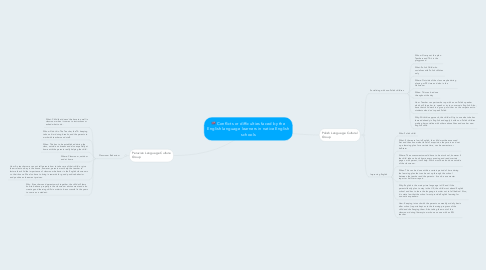
1. Polish Language Cultural Group
1.1. Socializing with non-Polish children
1.1.1. Who will carry out the plan: Teachers and TA's in the playground
1.1.2. What::Polish Child who socializes with Polish children only
1.1.3. Where: Outside of the class maybe during playing or PE time and also in the classroom
1.1.4. When: This can be done throughout the day
1.1.5. How: Teacher can partner her up with a non-Polish speaker which will force her to speak or try to converse in English. Also, have that child work in a group or sit her on the carpet next to students who don't speak Polish.
1.1.6. Why: With this approach, this child will try to use what she has learned already in English and apply it with non-Polish children making her socialize with other nationalities and use her new English skills.
1.2. Improving English
1.2.1. Who: Polish child:
1.2.2. What: If there are low in English, the child must be assessed first and then know what level of acqucision they are in and set up a learning plan for a certain time, can be semester or half-term
1.2.3. Where: The assessments would have to be at school, however if the child takes a book home every evening and reads certain pages with parent, it will help. Work must be also done outside of the classroom.
1.2.4. When: This can be done within a certain period of time during the learning plan that can be set up through the school between the teacher and the parents. It can be a semester report or half-term report.
1.2.5. Why: English is the main prime language in UK and if the parents/family plan to stay in the UK, the child must attend English school and has to learn the language in order not to fall behind. Also, it is state law that the school must provide English learning for non-native speakers.
1.2.6. How: Keeping in touch with the parents on weekly or daily basis after school, reports kept as to the learning progress of the child and challenging them. Also taking them out of the classroom during literacy to work one on one with an ESL teacher.
2. Peruvian Language Culture Group
2.1. Classroom Behaviour
2.1.1. What: Child that doesn't behave too well in classroom when it comes to instructions or asked what to do.
2.1.2. Who will do this: The Teacher, the TA keeping tabs on him during breaks, and the parents to work with teachers and staff.
2.1.3. When: This has to be established during the class, outside on breaks and also especially at home with the parents really helping the child.
2.1.4. Where: Classroom, outdoor and at home
2.1.5. How: As teachers we can not tell parents how to take care of their child or give them rules to obey in the house, however, parents must help the teacher to lecture the child the importance of classroom behavior in the English classrooms vs. their house. We also have to bring in rewards for good positive behavior and positive enforcement praises.
2.1.6. Why: If teachers and parents work together, the child will learn how to behave properly in the classroom environment and also create good learning skills in order to be successful in the years to come as a student.
